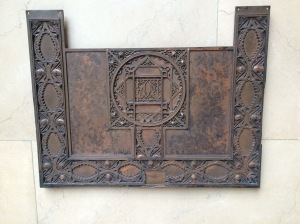Warning: this is going to be a long post! But it will mostly be photos. If a picture paints a thousand words and you are at an art museum…
Founded in 1879 as both a museum and a school for the fine arts, the Art Institite of Chicago’s permanent home was built in 1893 at the intersection of Michigan Avenue and Adams Street as a joint effort with the City of Chicago for the World’s Columbian Exhibition. The collection of the Art Institute of Chicago encompasses more than 5,000 years of human expression from cultures around the world and contains more than 260,000 works of art. The museum holds works of art ranging from early Japanese prints to modern American art. It is principally known for one of the United States’ finest collection of paintings produced in Western culture. It is the second largest museum in the United States, after the Metropolitan Museum of Art in New York.


That building still serves as the entryway, flanked by the bronze lions sculpted by Edward Kemeys. commissioned as a gift from Mrs. Henry Field (Florence Lathrop Field). While their official designations are the North Lion and the South Lion, Kemeys referred to them as On the Prowl (North) and Stands in Attitude of Defiance (South). Since all I knew about Chicago before this visit was from the John Hughes movies of the 1980s, I, of course, first saw them in the iconic AIC visit scenes from Ferris Bueller’s Day Off.



Despite my mission of taking a Ferris photo in front of the impressionist painting A Sunday on La Grande Jatte by Georges Suerat, I did allow myself to enjoy an exhibit on Chicago architectural history outside of the Impressionist Galleries.
And then my Ferris Bueller moment, finally!


I am not the only one who bases museum visits on pop cultural references; the museum has a handout on how to do the Ferris Bueller tour of the museum!
My second mission was to visit the Thorne miniature rooms, which I know from the beautiful book that was a gift from Robert Ward after he visited the miniature rooms and knew it was a collection that I would love. From the AIC website: “The 68 Thorne Miniature Rooms enable one to glimpse elements of European interiors from the late 13th century to the 1930s and American furnishings from the 17th century to the 1930s. Painstakingly constructed on a scale of one inch to one foot, these fascinating models were conceived by Mrs. James Ward Thorne of Chicago and constructed between 1932 and 1940 by master craftsmen according to her specifications.”
The rooms are very difficult to get good pictures of as they are behind glazing (understably; I would be able to resist touching!). An overview of the gallery:
Here are just a few of my favorites; I apologize for the poor quality of the images.






Traversing the museum, you go through the art and cultures of the world.





Some of the “Greatest Hits” at the AIC:



I was particularly drawn to a selection of works by one of my favorite painters, Georgia O’Keeffe, in the Paul and Gabriella Rosenbaum Gallery, a gallery dedicated to Georgia O’Keeffe and Alfred Stieglitz. O’Keeffe studied at the School of the Art Institute of Chicago beginning in 1905.






And now, for a few things that I call Weird and Creepy for lack of a better description.



And the final category, which I call Things I Like.


I was thinking Mary of Burgundy seemed like a kick-ass kind of gal, but then I read on the label that this sculpture depicts her in the moment before her tragic and fatal fall.





And, of course, we exit through the gift shop! Yes, money was spent.
That concludes our whirlwind tour of the Art Institute of Chicago. Still to come: The Chicago Cultural Center, the Palmer House, and more!





































